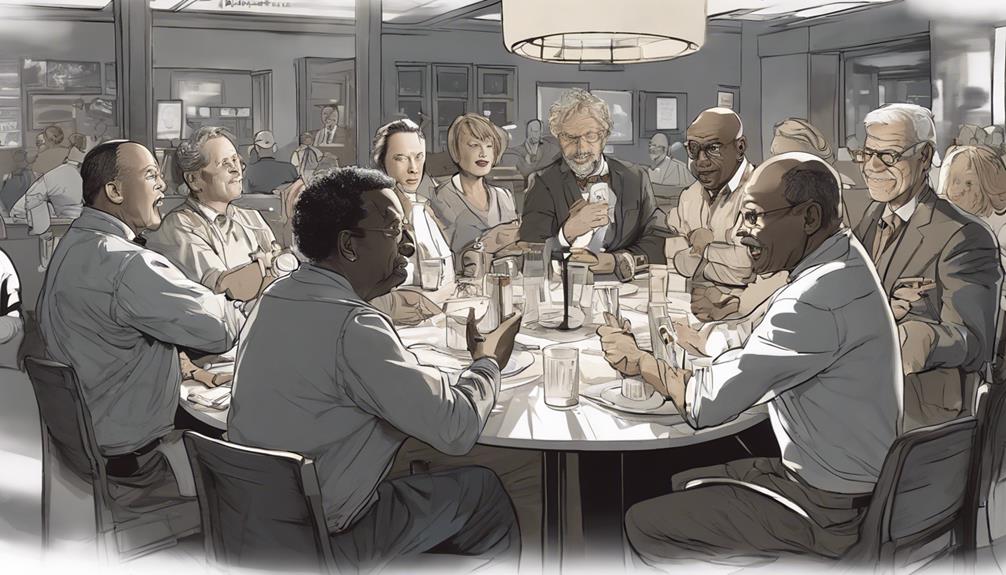Ghosting often stems from attachment styles and emotional avoidance, where individuals withdraw to protect themselves from vulnerability or conflict. If someone has an avoidant attachment, they might ghost to escape intimacy, while those with anxious attachment may feel hurt and try to seek reassurance. Understanding these patterns helps you realize it’s not about personal rejection. To navigate this, recognize the underlying reasons and respond with compassion—there’s more to uncover if you stay curious.
Key Takeaways
- Ghosting often stems from avoidant attachment, where individuals withdraw to prevent emotional vulnerability.
- Anxious attachment may lead to intense hurt and repeated outreach after being ghosted.
- Understanding attachment styles helps prevent self-blame and fosters compassion for the ghoster’s behavior.
- Respond by setting boundaries, maintaining self-esteem, and communicating openly in future relationships.
- Recognizing emotional avoidance allows for healthier reactions and promotes genuine, honest connections.

Ghosting has become a common way for people to end relationships abruptly, often leaving the other person confused and hurt. When someone ghosts you, it can feel like a sudden wall has gone up, cutting off all communication without explanation. This behavior is often rooted in emotional avoidance—where a person struggles to confront uncomfortable feelings or face conflict directly. Instead of having an honest conversation, they choose to disappear, avoiding the emotional discomfort that comes with difficult conversations. This pattern can create a communication breakdown, leaving you to wonder what went wrong and whether you did something to cause it.
Understanding how your attachment style influences this behavior is key to making sense of why ghosting happens. For individuals with avoidant attachment styles, ghosting may be a defense mechanism. These people tend to shy away from intimacy and emotional closeness because they fear being overwhelmed or vulnerable. To protect themselves, they might withdraw suddenly rather than risk an emotionally charged discussion. Their avoidance isn’t necessarily about you personally, but about their own discomfort with emotional expression. Recognizing this can help you avoid taking ghosting as a reflection of your worth, and instead see it as a sign of their internal struggle.
On the other hand, those with anxious attachment styles might be more prone to seeking reassurance and fearing abandonment. When they experience a communication breakdown or sense emotional distance, they may become anxious and desperately try to reach out, hoping to restore connection. If they don’t get the response they want, they might interpret silence as rejection, which can make them feel even more hurt and confused. Sometimes, the person who ghosts is actually someone overwhelmed by their own fears and unable to navigate their emotions, which leads them to retreat instead of confronting the issues.
If you’ve been ghosted, the most helpful response is to recognize the underlying attachment-style dynamics at play. Instead of dwelling on self-blame, remind yourself that the behavior says more about their emotional state than your worth. Focus on establishing healthy boundaries and maintaining your self-esteem. It’s also essential to communicate openly in future relationships about your needs and feelings, encouraging a culture of honesty rather than avoidance. While it’s painful to experience a sudden disappearance, understanding the emotional avoidance behind ghosting can help you respond with compassion and clarity, rather than anger or despair. Remember, you deserve relationships grounded in genuine communication, where feelings are expressed and conflicts are addressed directly.
Frequently Asked Questions
Can Attachment Styles Change Over Time or With Therapy?
You might wonder if attachment styles can change over time or with therapy. The answer is yes, there’s potential for attachment evolution, especially when you actively engage in therapy. Therapy impact can help you understand your patterns, develop healthier relationships, and shift towards secure attachment. While change takes effort and patience, it’s entirely possible to evolve your attachment style, leading to more fulfilling connections and better emotional resilience.
Is Ghosting More Common in Certain Attachment Styles?
You might notice that ghosting is more common among those with attachment avoidance or anxious attachment. People with attachment avoidance often withdraw suddenly, making ghosting easier for them. Meanwhile, those with anxious attachment might ghost because they fear rejection or confrontation. Understanding these tendencies helps you see why certain attachment styles are linked to ghosting behaviors, and it encourages you to communicate more openly rather than withdrawing abruptly.
How Can I Identify My Own Attachment Style?
To identify your attachment style, focus on self-awareness strategies like reflecting on your relationship patterns, emotional responses, and how you handle intimacy and conflict. Pay attention to your reactions in close connections—do you seek closeness or withdraw? Recognizing these behaviors helps you understand your attachment style. Regularly journaling or talking with a therapist can enhance your attachment style recognition, giving you insights that improve your relationships and emotional health.
Are There Cultural Differences in Ghosting Behaviors?
You might notice that cultural norms and dating etiquette influence ghosting behaviors across different societies. In some cultures, ghosting is seen as more acceptable or common, while others value direct communication and honesty. These differences shape how people respond to romantic situations. Understanding these cultural variations helps you interpret ghosting better, recognizing that what’s considered polite or rude varies widely, and it can guide you on how to handle ghosting in your own cultural context.
What Are the Long-Term Effects of Ghosting on Relationships?
Did you know that 60% of people report lasting emotional scars from ghosting? Long-term, ghosting can cause trust issues and emotional wounds that linger, affecting future relationships. You might find it harder to open up or feel secure with new partners. These unresolved feelings can lead to ongoing insecurity and fear of rejection, making it tough to build healthy, trusting connections down the line.
Conclusion
Understanding ghosting through the lens of attachment styles is like decoding a secret language. When you recognize your own style and others’, you gain clarity and compassion—think of it as finding the map in a maze. Remember, even in the shadows of uncertainty, your worth shines brightly. Just as the night reveals the stars, embracing this knowledge can illuminate healthier connections and brighter tomorrows. Don’t let ghosting define you—use it as a guide toward self-awareness and growth.
Felicity, our Author, pens in-depth articles and guides that delve into the heart of personal discovery. Her narrative-driven approach weaves together theory, practice, and personal anecdotes, making the journey of self-exploration both relatable and inspiring. Felicity’s contributions help illuminate the path for those seeking a deeper understanding of themselves and their relationships.










